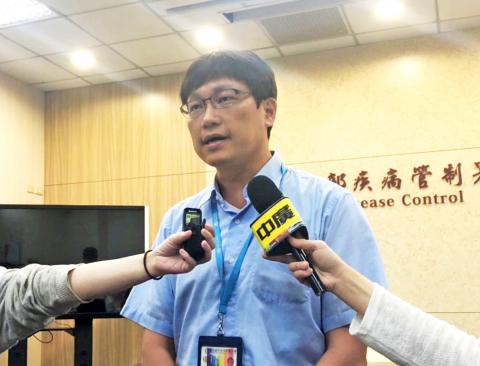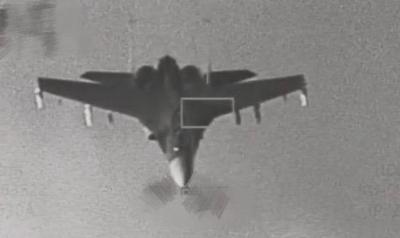The Centers for Disease Control (CDC) on Friday confirmed this year’s first Japanese encephalitis case, urging people to take precautionary measures against mosquito bites as the disease’s peak season approaches.
A man in his 60s from Kaohsiung on May 1 started showing symptoms of fever, headache, convulsions and loss of consciousness, and was immediately hospitalized, the centers said.
He was reported as a suspected case and transferred to another hospital for further treatment on May 5, with test results on Friday confirming that he was infected with Japanese encephalitis, it said.

Photo: CNA
He has since slipped into a coma and is being treated at an intensive care unit, the CDC said.
The man had visited a friend in Kaohsiung’s Daliao District (大寮) and a natural recreational area in Fengshan District (鳳山) during the incubation period, CDC physician Lin Yung-ching (林詠青) said, adding that there is a pig farm and meat market as well as rice paddies near the places he visited, so he might have been infected there.
The Japanese encephalitis season lasts from May to October, with June and July the peak period, Lin said.
Most people show mild to no symptoms at all, but in some cases the patient might develop a headache, fever or aseptic meningitis, which could progress to loss of consciousness, seizures and ultimately death, he said.
About 30 to 50 percent of those who survive the serious symptoms are left with permanent brain damage, muscle weakness, learning difficulties or personality changes, Lin said, adding that young children, elderly people and people with weak immune systems are at higher risk of developing serious symptoms.
Getting vaccinated is the best prevention method, the CDC said, urging parents to have children above 15 months to get vaccinated at local health departments or contracted hospitals.
People should avoid rice paddies, ponds, trenches, animal farms and other places mosquitoes inhabit, especially at dawn and dusk, when they are most active, and take protective measures against mosquito bites when going outdoors, the CDC said.

Trips for more than 100,000 international and domestic air travelers could be disrupted as China launches a military exercise around Taiwan today, Taiwan’s Civil Aviation Administration (CAA) said yesterday. The exercise could affect nearly 900 flights scheduled to enter the Taipei Flight Information Region (FIR) during the exercise window, it added. A notice issued by the Chinese Civil Aviation Administration showed there would be seven temporary zones around the Taiwan Strait which would be used for live-fire exercises, lasting from 8am to 6pm today. All aircraft are prohibited from entering during exercise, it says. Taipei FIR has 14 international air routes and

Taiwan lacks effective and cost-efficient armaments to intercept rockets, making the planned “T-Dome” interception system necessary, two experts said on Tuesday. The concerns were raised after China’s military fired two waves of rockets during live-fire drills around Taiwan on Tuesday, part of two-day exercises code-named “Justice Mission 2025.” The first wave involved 17 rockets launched at 9am from Pingtan in China’s Fujian Province, according to Lieutenant General Hsieh Jih-sheng (謝日升) of the Office of the Deputy Chief of the General Staff for Intelligence at the Ministry of National Defense. Those rockets landed 70 nautical miles (129.6km) northeast of Keelung without flying over Taiwan,

City buses in Taipei and New Taipei City, as well as the Taipei MRT, would on Saturday begin accepting QR code payments from five electronic payment providers, the Taipei Department of Transportation said yesterday. The new option would allow passengers to use the “transportation QR code” feature from EasyWallet, iPass Money, iCash Pay, Jkopay or PXPay Plus. Passengers should open their preferred electronic payment app, select the “transportation code” — not the regular payment code — unlock it, and scan the code at ticket readers or gates, General Planning Division Director-General Liu Kuo-chu (劉國著) said. People should move through the

The Ministry of National Defense (MND) today released images of the military tracking China’s People's Liberation Army (PLA) movements during the latest round of Chinese drills around Taiwan. The PLA began "Justice Mission 2025" drills today, carrying out live-fire drills, simulated strikes on land and maritime targets, and exercises to blockade the nation's main ports. The exercises are to continue tomorrow, with the PLA announcing sea and air space restrictions for five zones around Taiwan for 10 hours starting from 8:30am. The ministry today released images showing a Chinese J-16 fighter jet tracked by a F-16V Block 20 jet and the